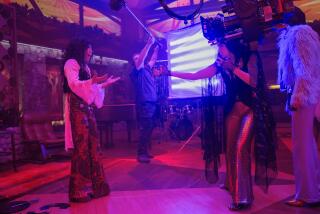Salem Bows to Gallows Humor With 300th-Anniversary Witch Festival : Tourism: Not everyone is thrilled by the commemoration of infamy. The town hopes to attract 1 million visitors.
- Share via
SALEM, Mass. — To her neighbors in 17th-Century Salem, Bridget Bishop was . . . well, let’s just say she had a reputation. She ran a tavern in her home, played shuffleboard with the town’s young men into the wee hours and wore flashy, expensive dresses.
And, the townspeople whispered, Bridget was a witch.
She was among the many--men as well as women--to be accused of witchcraft in 1692 by a band of convulsive, screaming girls, and hers was the first case tried in court. Evidence against her was, to Puritan minds, strong: In addition to her disreputable personality, she had been accused of witchcraft before, when a doll representing a person and stuck with hog bristles was found in her basement.
For that Bishop was convicted of witchcraft. Eight days later, June 10, 1692, she was carried through town on a two-wheeled cart to Gallows Hill, where two upright posts with a crossbeam stood. She was hanged as a crowd stood and watched.
The town where the hysteria began, Salem Village, has long since changed its name to Danvers. The people of Salem, where the trials and executions took place, kept their name, though realizing the town would never escape the label “Witch City.” Now, nearly 300 years later, the community stands ready to celebrate the historic witch trials.
It is an unusual observance, given its chilling source, but it comes after many years of resignation to infamy. There is a lightness now about the trials that weighed so heavily on our ancestors.
Police and firefighter patches bear the silhouette of a witch on a broomstick. There’s an official witch of the town. And there’s even a Witch City Bar & Grill and Witch City Auto Body. One of the few somber moments comes each Halloween when local witches march to Gallows Hill and cut a symbolic noose.
“Salem has built a reputation for itself on the witches,” said the Rev. Marta Flanagan of Salem’s First Universalist Church. “Here’s this hot item we have that raises people’s interest level.”
And it’s getting hotter. As the 300th anniversary draws near, officials of this city of 38,000, about 15 miles north of Boston, hope that the festival attracts 1 million tourists.
Events include an appearance by playwright Arthur Miller, whose “The Crucible” compared the trials to the anticommunist hysteria of the 1950s. There also will be a televised re-enactment of the trials featuring Harvard Law School professors Alan Dershowitz and Arthur Miller (not the playwright). There is a design contest for a memorial to the victims. And there is even a road race on the agenda.
But not everyone finds the occasion so rousing, especially in Danvers, where, according to town archivist Richard Trask, the descendants of the Salem Villagers did not loosen up about the witch trials for many years.
“The attitude thing was in Danvers up until the 1960s. The center of Salem Village tended to have the same families living in it that had lived there 300 years ago--people whose ancestors were hangers and hangees,” said Trask.
Talk to people on the red brick streets of Salem today, and you don’t have to go far to find concern about the hoopla--especially the witches.
Salem’s witches, who claim that they number more than 2,000, say they have been left out of the planning and that a fair picture of them won’t be presented. They have even cast a spell on the city, seeking to turn the events around.
“If we have a million people come through Salem and let them walk out thinking we consort with the devil, isn’t that harmful?” said Laurie Cabot, dubbed the official witch of Salem, who sports flowing black robes and hair and wears a five-pointed star on her shoulder. “If they held a festival on (American Indians), would they just show Roy Rogers pictures?”
Linda McConchie, executive director of the committee planning the events, admitted that “some people feel it’s shameful or inappropriate to discuss the trials,” but added, “we feel we have an obligation to confront history.”
The Rev. Flanagan is less critical.
“Sure, people are going to try and make a buck off this,” Flanagan said. “But at the same time the trials have a powerful lesson, whether it’s how we treat witches, or gay people, or blacks, people who are different, without killing them.”
The witch hysteria began in January, 1692, when a group of young girls came down with violent fits of screaming and shaking. There were reports that some of them had welts and teeth marks on their bodies.
“This wasn’t just kids fooling around,” said Trask, the Danvers archivist. “If this happened today it would scare the hell out of you.”
Tradition has it that the girls, among them the daughter of the local minister, became disturbed after Tituba, a West Indian slave, told them colorful stories about sorcery. Some researchers have theorized that the girls were affected by a hallucinogenic fungus on the local wheat. Others think it was a form of mass hysteria.
Colonial doctors had another diagnosis: witchcraft. Such a finding wasn’t uncommon; thousands of accused witches had been burned at the stake in Europe, and many Puritans believed in them.
The girls were pressured to identify the source of their torment, and some were fed a witch cake--made from rye meal and their urine--to help them in their disclosures. The girls began crying out the names of townspeople. More girls were afflicted, the accusations snowballed and dozens of people were dragged in for questioning and jailed. At one point, 160 members of more than a dozen communities stood accused. One was a 4-year-old girl.
Quiet hearings they weren’t, with the girls writhing and shrieking that the accused were hurting them.
In one hearing, an accused warlock named George Jacobs exclaimed: “Burn me or hang me but I’ll stand in the truth of Christ!” In a less charitable moment, he called the hysterical girls “witch-bitches.”
Even after she was convicted, Mary Easty petitioned the court on the behalf of others jailed, pleading for their release.
“I petition your honors not for my own life, for I know I must die and my appointed time is set,” Easty wrote. “But the Lord He knows . . . that if it be possible, no more innocent blood may be shed.”
As a result of the trials, which began in Salem in June and lasted four months, five men and 14 women were convicted and hanged. One man was crushed to death by stones as he was tortured to make a confession, and five others died in jail.
As word spread that the tribunal was a hanging court, scores of the accused confessed. They were not hanged, but instead jailed to testify against others. They probably would have been hanged eventually, historians say, but the prosecutors focused on those who kept silent or maintained their innocence. They were the ones executed.
By the end of October, pressure from community leaders forced the court to dissolve. A new court acquitted the rest. Years later, Ann Putnam, one of the afflicted girls, acknowledged her responsibility for the deaths. Samuel Sewall, one of the judges, stood with his head bowed in Boston’s Old South Church and publicly asked forgiveness five years after the trials ended.
The trials were more than a rift in Salem; they were a crossroads of history, said John Demos, Yale University historian and author of “Entertaining Satan: Witchcraft and the Culture of Early New England.”
“We were moving away from a pre-modern, pre-industrial and pre-capitalist way of life to something more modern. Old values were giving way in the face of a much more individualized and self-seeking spirit,” Demos said. “The trials were an attempt to turn back the clock by one group of people who cast themselves as accusers.”
He said the trials “exposed the fundamental tensions of the age.” He also said the witches were typical of history’s scapegoats, and “it became convenient to blame bad things on witches, as opposed to the idea that the universe was full of random difficulty.”
Trask, the Danvers archivist, said the Salem trials can remind every age of what happens with the loss of reason. He cited parallels such as the McCarthy era, Civil War days, Arab-bashing during the Persian Gulf War and the internment of Japanese Americans during World War II.
In the end, Trask and other historians say, the story of the Salem witches is not a sad one. Trask said many of the accused showed inspired bravery, as did a handful of influential residents who worked to stop the proceedings.
“These people weren’t saints, by any means. Many of them were flawed,” Trask said. “But in a time when their community was in crisis, when religious and civic authorities had failed, they stood up against all of that. And they became heroes.”
Trask is a descendant of Mary Easty.
More to Read
Sign up for The Wild
We’ll help you find the best places to hike, bike and run, as well as the perfect silent spots for meditation and yoga.
You may occasionally receive promotional content from the Los Angeles Times.






